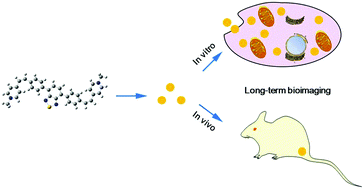A photostable cationic fluorophore for long-term bioimaging†
Abstract
Fluorophores for efficient long-term bioimaging are of great importance to fully understand the cellular and molecular processes of disease. In this study, a bright and photostable cationic fluorophore (PPB) was successfully developed as a long-term tracer. The PPB displayed advanced properties such as high fluorescence efficiency, large Stokes shift, low cytotoxicity, and good biocompatibility. Moreover, the PPB exhibited comparable photostability to the commercial cell tracker Qtracker 585. More importantly, the PPB can trace HeLa cells as long as 16 passages in vitro and monitor tumor growth for 27 days in vivo. These remarkable features endow the PPB as an ideal fluorescent probe for long-term bioimaging applications.



 Please wait while we load your content...
Please wait while we load your content...